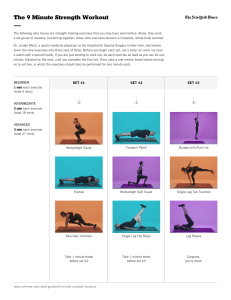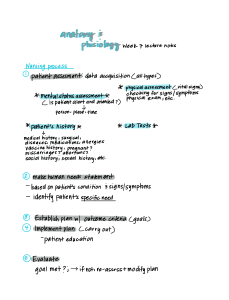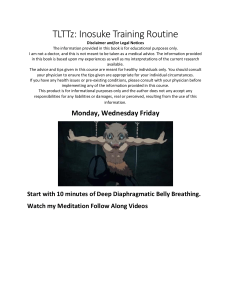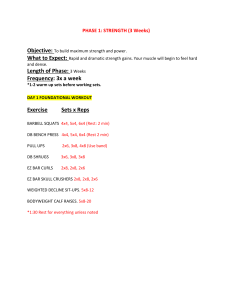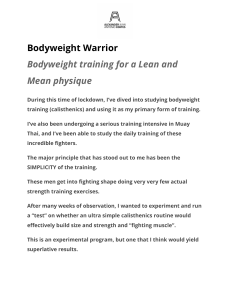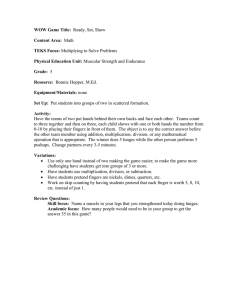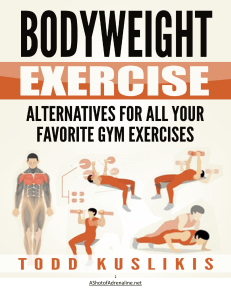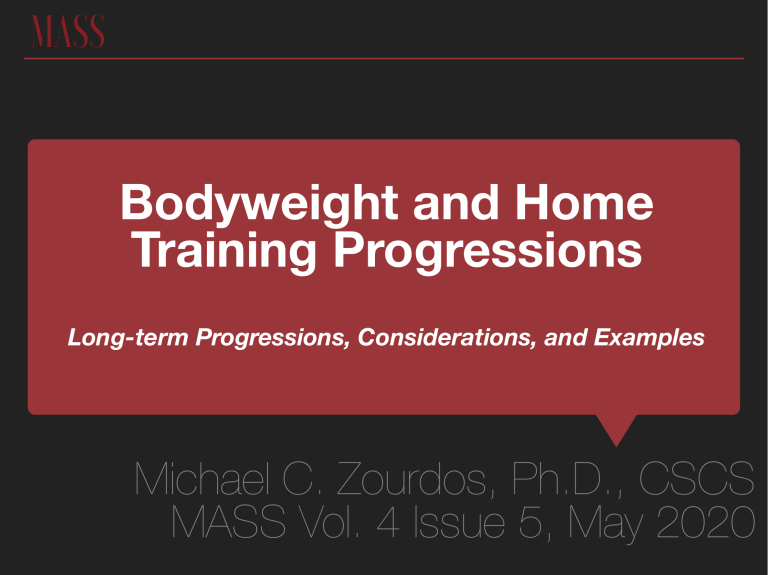
Bodyweight and Home Training Progressions Long-term Progressions, Considerations, and Examples Michael C. Zourdos, Ph.D., CSCS MASS Vol. 4 Issue 5, May 2020 Today’s Objectives 1. Examine the magnitude of strength and hypertrophy gains that is seen in the existing scientific data from bodyweight training 2. Provide examples of bodyweight or possible home exercises with resistance 3. Demonstrate the basic structure of bodyweight/home training 4. Provide clear examples of progression strategies for volume, frequency, and load 5. Detail a specific program that can be used in this situation 6. Discuss what can be maintained during bodyweight/home training once you return to the gym Rate of Progress With Bodyweight Training Bench Press Group: 3 sets of 40% of 1RM to failure 2 times per week Pushup Group: 3 sets twice per week to failure with position (bent knees or hands up) so that the load was adjusted to the same amount as the bench press 8-Week Study: Subjects with 1-year of training experience Hypertrophy Results +22.35% +26.40% +10.55% +5.70% Rate of Progress With Bodyweight Training Bench Press Group: 3 sets of 40% of 1RM to failure 2 times per week Pushup Group: 3 sets twice per week to failure with position (bent knees or hands up) so that the load was adjusted to the same amount as the bench press 8-Week Study: Strength Results 8.33% 5.07% Rate of Progress With Bodyweight Training Bench Press Group: 5X6, 2 times per week for 6 weeks Pushup Group: 5X6, 2 times per week for 6 weeks Elastic Bands added to pushup to equate for muscle activation between bench and pushups Strength Results – 6RM Bench Press Strength Results – 1RM Bench Press Rate of Progress With Bodyweight Training 2 groups performing bodyweight pullups 2X/wk. for 8 weeks Group 1: Performed reps on each set until 25% velocity loss Group 2: Performed reps on each set until 50% velocity loss Elastic Bands added to pushup to equate for muscle activation between bench and pushups Strength Results – Pullup Group Pre-Test 1RM (kg) Post-Test 1RM (kg) Percentage Increase 25% Velocity Loss 108.4 ± 10.4 114.3 ± 8.9 +5.4% 50% Velocity Loss 114.4 ± 20.8 115.2 ± 19.8 +0.69% Notes and Thoughts From the Data ‣ Bodyweight training did cause hypertrophy and increase strength in individuals with some training experience ‣ It’s a matter of expectations ‣ Do you expect to get bigger and stronger as though you are in the gym? ‣ Or do you expect to do what you can to maintain your size as much as possible? ‣ Remember the rate of decline from detraining is less than you might expect, so performing bodyweight training for a few months to even attenuate that, should have you in a pretty good spot ‣ Even if you lose neural adaptations on a main lift, body weight training could help mitigate the loss of much and help to aid strength when you return A REMINDER 20 Weeks of Training, 30 weeks of Detraining, 6 weeks of Retraining Trained 2x per week at 6-8RM and 10-12RM In college-aged women there was a decrease in strength after detraining, but perhaps not as much as you might think +40% +67% -13% +40% Staron et al. 1991 Data Conclusions ‣ You can get a good stimulus by training at home or with just bodyweight ‣ Should you expect the results to tbe the same as your normal training? Depending on the goal, probably not. ‣ But, you’ll be in a much better position when you return to the gym than if you do nothing So, How Do You Train at Home? ‣ Exercises ‣ I’m going to assume you have nothing ‣ If you have some DBs or weight plates or bands, awesome, USE THEM ‣ Notes ‣ Later on, in the programming example, you can add some exercises if you have other equipment or you can add bands to a pushup or perform any variation with this extra equipment ‣ The program is of course a conceptual example. But, I want this to be useful for even those who don’t have anything at home, adding stuff if you have it, should be simple Exercise Library (Not Comprehensive) ‣ ‣ ‣ ‣ ‣ ‣ ‣ ‣ ‣ ‣ ‣ ‣ ‣ Pushups and variations (feet up, knees down, hands elevated, close grip, wide grip, diamond) Sit-Ups Pullups/Chinups (STRONG door frame, tree branch, kid’s playground, metal beam) Squats (bodyweight, goblet, back, front, pistol, goblet) Lunges (bodyweight, reverse, walking) Split squats Rows (wide grip, neutral grip) Dips (chairs, countertops) Overhead pressing Upright rows Lateral / front raises Shrugs Bodyweight Core work (planks and crunch variations) SOME EXAMPLES ‣ ‣ ‣ ‣ ‣ ‣ ‣ ‣ ‣ Fill handheld cooler (rows, lunge variations, RDLs, Floor Presses) Hold textbooks (rows, lunge variations, raises) Fill backpack (squats, walking lunges) Fill canvas bags (curls, raises, lunges, rows, upright row) Paint cans (curls, raises, lunges, rows, upright row, front squat) Bags of flour/sugar (overhead press, goblet squat) Dog food (overhead triceps ext., goblet squat) Cases of water (overhead press) Extra bricks, flooring (anything you might have had to work around your house) ‣ Splits squats, lunges, raises ‣ Grip work HAVE FUN, IT IS OUT OF YOUR CONTROL Our Goal ‣ Let’s put together a 2 month home training program ‣ This program assumes you have no traditional lifting equipment ‣ For all exercises listed, choose one of the examples that is listed on the previous slides to perform it (i.e. for “split squats” hold textbooks in your hand) ‣ If you have some DBs or plates, use them ‣ The loads or amount of starting reps (i.e. on pushups) ARE not universal. You will need to adjust that for your strength level, this is a conceptual guide ‣ You’ll see “Paint Can Curls” 3 sets to 5-7RPE…this may be a better loading strategy than saying: 3X8 @6-8RPE because we don’t necessarily know the load and your loading increments may be restricted ‣ Although, you can add load by adding a water bottle to a canvas bag or a book to a backpack and if you have a scale, you can of course weight that object First Week, Intro: Getting Acclimated ‣ Feeling things out a bit, other than maybe pushups, you won’t really know how good you are at these exercises or how much weight to load into your backpack for squats ‣ Your gym may have closed and you may have had a week off before starting home training ‣ This is still novel training compared to what you have likely been doing ‣ What We Will Do ‣ Three total training days ‣ Frequency of about twice per week for each muscle group INTRO WEEK INTRO WEEK ‣ Feeling it out a bit ‣ You’ll always acclimate to exercise like overhead press, which are a bit awkward at first ‣ Maybe just getting motivated again ‣ The descriptions in the ”weights” and “RPE” column are a bit different than normal, but the will help you remember how the exercise felt when you do it again ‣ Programming reps may be a bit different because you may only have so many options ‣ You may be a bit sore, since it is all new, that’s okay Block 1: Weeks 1-4 ‣ Training harder ‣ Adapting to the exercises ‣ What We Will Do ‣ Four total training days ‣ Frequency of at least twice per week on each muscle group ‣ Progressing load and demonstrating a guide for progression WEEK 1 WEEKS 2-4 PROGRESSION OPTIONS ‣ Add weight ‣ Add a canned food or bottle of water ‣ Add a textbook (lots of options for a backpack) ‣ Fill a water jug ‣ Add reps ‣ If you have 3 sets to a 6-8RPE, then you have overload built in ‣ This will come in handy if you are using a paint can and it is difficult or akward to add to ‣ Or walking lunges/pushups, just add reps ‣ Fewer sets to get through pushups ‣ Add sets BLOCK 1: WEEKS 1-4 ‣ Increased frequency ‣ Utilized progressive overload schemes ‣ Training for real a bit Block 2: Weeks 5-8 ‣ Increasing frequency ‣ Increasing volume ‣ You may be more motivated now, and settled into a routine so you may want to train more ‣ If not, then continue to train 2-4 days per week, that is perfectly fine, this is just an example of how you could progress this ‣ What We Will Do ‣ Six total training days ‣ Frequency of at least twice per week on each muscle group WEEKS 5-8 BLOCK 2: WEEKS 5-8 ‣ Increased frequency, 6 total days ‣ Pushups up to 4 times per week ‣ This would not be easy Other Aspects of Home Training / Thoughts ‣ Have fun ‣ It’s time for something new ‣ Don’t stress over not being able to do what you usually do ‣ If you want to change the program and do something else, then do it, especially if it brings you joy while you are home ‣ If you want to train more…DO IT ‣ If you want to train less…DO IT ‣ Do whatever you need during this time, the previous example is just an option ‣ If you don’t want to go to 6 days per week, then continue with block 1 ‣ If you want to do pushups every single day, then do them if you are staying healthy Other Times You May Use Bodyweight Home Training ‣ You have a kid and your partner is away ‣ Really busy time and traveling to the gym is too time-consuming ‣ Family visiting for holidays or extended stay and hard to leave the house ‣ Just want to do something different In other words, this can still be useful in times outside of COVID-19 Applications and Takeaways v Data indicate that bodyweight training can indeed help to maintain size and strength v There are many items around the house that you can turn into resistance training equipment (the list in this slide show is not comprehensive) v There are many progression options, just be inventive v When circumstance relegate you to bodyweight or home training, it may not be easy, but hopefully this guide helps, you can still do something if you wish

